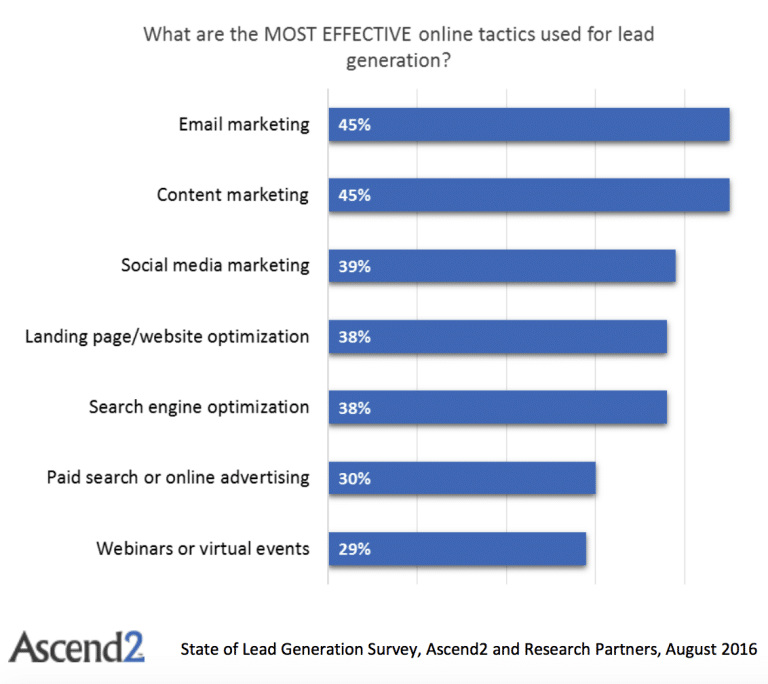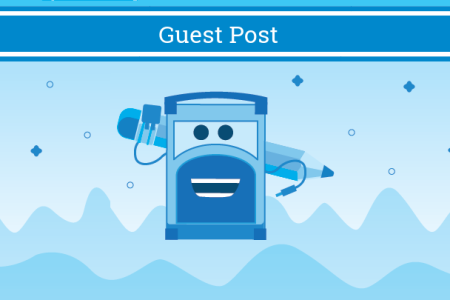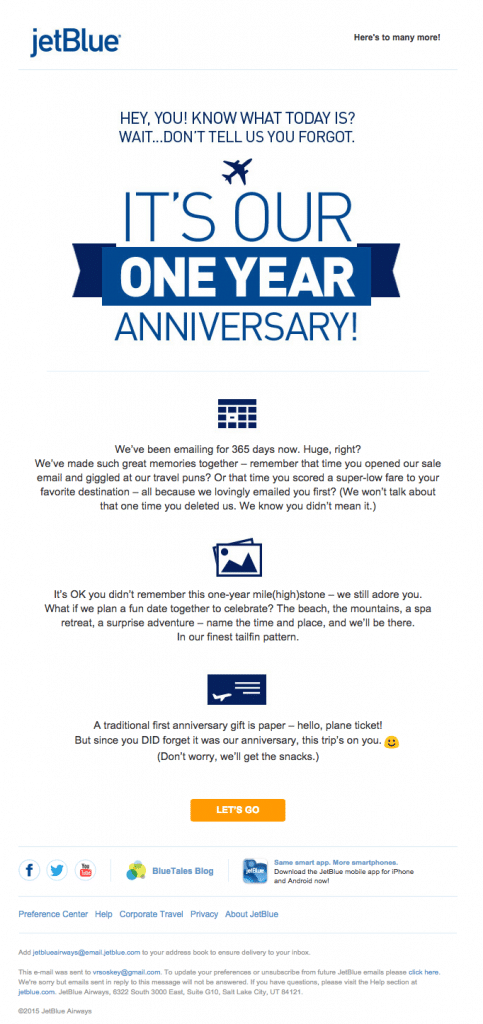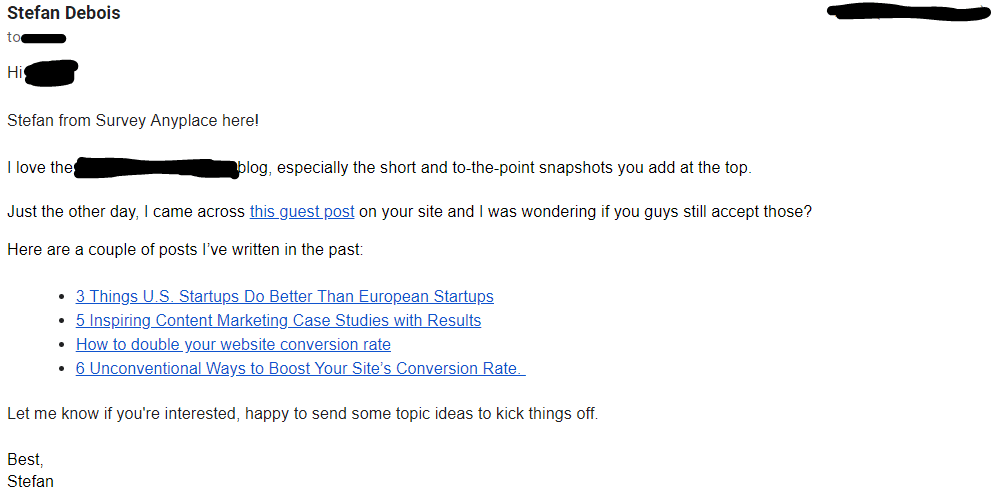Email marketing has been around since forever. It may not be as sexy as AI or augmented reality, but it isn’t going anywhere anytime soon. Here’s why: Email marketing has an ROI of 4400%
That makes it the most profitable marketing channel available. For every $1 spent, email marketing generates $44 in ROI.
Email open rates hover around 25%, making your message 12 times more likely to be seen through email as compared to Facebook’s 2% organic reach or AdWords’ 1.91% click-through rate. As you can see in the chart below, most marketers agree that is email marketing is still the best tactic for lead generation

But how do you leverage this medium? To start, you need the perfect email and email design. You might argue such a thing is doesn’t exist. but armed with these tips and tricks from several experts on the matter, you’ll come pretty close.
The subject line
Let’s start with the first thing people will read: the subject line. Did you know, 47% of emails are opened or discarded based on their subject line.
To be honest, there is no one subject line to rule them all – the perfect one will largely depend of the goal or purpose of the email.
In most cases, whether it’s asking for a link or a request to fill out your survey, you’re asking readers to do something for you. But if you ask for the favor right in the subject line, they’ll think to themselves, “I’ll read or do this later,” and then forget about it.
That’s why Mark Lindquist from Mailshake uses short one to three word subject lines for these kinds of emails: “The only way to drive engagement from an email is to get your recipient to open it, and that all comes down to the subject line. I have two approaches to subject lines: The first is a two word, very general subject line like ‘Quick question’ or ‘Your thoughts?’. It’s intriguing and reads like a personal email instead of a big marketing blast.
“The second is just to ask what you’re asking. This one is longer, and it summarizes in six or so words the purpose of the email. An example would be ‘Featuring [the recipient’s company] as a top sales tool’. I use that one when I think the ask is super compelling, and I want to make sure the recipient sees it.
“My open rate on that subject line, by the way, was almost 95%, and the email itself got a reply rate of 53%. The power of a compelling offer!” To ensure secure email campaign experience, consider creating a Zendesk SPF record to authorize them to send emails using your own domain
Other subject line examples for Mark’s second approach are:
- An addition to your article on [topic]
- Include [company] in an upcoming article
- I totally admire the idea you shared
Most of these effective examples contain a variable, because subject lines with at least some personalization increase email engagement with 22%.
The email body
Okay, your recipient has opened your email. So far, so good.
Now it’s onto the body of the email. It’s no secret great copywriting is important, but to shed more light on the matter, I’ve reached out to a couple email marketing experts to learn what makes great email copy. Here’s what they had to say:
“Avoid superfluous copywriting. Keep it short and concise. Break up paragraphs into 2–5 sentences to make it easy for people to quickly scan your email and locate the important details.” – Eric Jackson, CEO of CapLinked
“Use the right tone. Apply your branding and voice guidelines to your email marketing. Like communications across social media platforms and your website, you should tailor the voice and messaging to your audience while remaining consistent in your brand personality and voice.” – Tahnee Elliott, Founder/CEO of T.C. Elli’s
“Add an element of personalization. The difference between an email with no personalization beyond the recipient’s name, and just one element of personalization is huge. It turns what appears to almost certainly be a mass email into something that at least had a little effort put into it. That little bit of perceived effort puts you ahead of 90% of the cold emailers out there.” – Mark Lindquist, Marketing Strategist of Mailshake
How does this translate to your actual email? Here’s an example from JetBlue, using something as simple as the signup date to personalize it’s one-year anniversary email.
Do a little research on your recipient
What’s their company called? How does the person like to be addressed? Even small mistakes, like in the email below (It’s Survey Anyplace and not Survey any place) are the fastest way to get your email in the trash.
When it comes to email body length, shorter is better. For most, keeping up with their inbox is a necessary evil, so have the KISS (“Keep it simple, stupid”) principle in mind. Obviously, there’s always room for your personality and some experimenting, but in my experience, people prefer it when you get straight to the point.
Worry less about word count and more about white space
Take a look at these two emails:
vs.
Which one seems the longest? Which one is more readable? Many marketers are concerned about being as concise as possible in their emails. And many of them judge that by the number of words and sentences. Smart use of whitespace does the same thing.
Take advantage of bullet points, limit paragraphs to fewer than two sentences, and focus more on white space in your next email rather than the sentence or word count.
Include something interactive
Another great way to spice up your emails is by including a quiz or puzzle in your curated newsletter from time to time. Make sure your email subject contains a teaser, such as a challenging number like this one: “Only 1 in 50 People Can Identify These 16 Grammar Mistakes. Can You?”
A call to action
So, your recipient has opened the email and read it. We have two out of three boxes ticked. Now it’s time to pull them across the threshold and make them do what we contacted them for.
You do that with the perfect call to action (CTA). To craft such a call to action, ask yourself three questions:
- What do I want the reader to do?
- Why should they do it?
- How will they know to do it?
Less is more, as one study found that click-through rates increased by 42% when the number of CTAs in an email decreased from four to just one. Limit the click-through options and guide your recipient to that one, most important CTA or action.
Optimizing your call to action increases click-through rates, drives conversions, and ultimately increases revenue.
- Be specific: Opt for “Buy it today” or “Order now” instead of “Click here” or “Learn more”.
- A/B test your CTA using a smaller portion of your list: Then, you can move forward with the best performing one.
- Keep it simple: Ask a basic yes/no question. This makes it incredibly easy for them to respond to your email, and it opens it up for them to say no to your offer.
- Consider the timing of your email: According to Ryan Farley, co-founder LawnStarter, “I like spreading emails out randomly throughout the day to gather data on the best time my subscribers open and engage, and then use that data to optimize.”
Who should you contact?
Apart from what you write in your email, it’s equally important to reach the right people with your email.
“Your ‘who’ needs to be a North Star that guides your email marketing strategy, messaging, and timing. Relevance in content is key: Great content for the right set of contacts at the right time can bring measurable value to your brand but great content for the wrong audience will quickly fall flat. Ask yourself, ‘Who is the right person for this email?'” – Tahnee Elliott, Founder/CEO of T.C. Elli’s
You need to be deliberate about who you ask. Who are you emailing? What do they normally write about? What’s a relevant success you could mention? How will your email benefit them and their readers?
This technique works great if you’re asking referrals or recommendations. Look at the customers who are already happy with what you do. These customers are most likely to provide you with positive recommendations and would be willing to refer you to their friends.
Conclusion
In my opinion, driving high rates of email opens and engagement is all about doing what others aren’t doing. A well-written and well-timed email pitch can deliver a seriously effective bang for your buck and look great in your copywriting portfolio.
However, using that philosophy, all best practices eventually expire, as others catch on and users become fatigued by reading the same thing over and over again.
I like to keep an email account I use to subscribe to all sorts of marketing newsletters and see what subject lines and formats stand out. Then, I test them on my own audience and see what sticks.
Stefan Debois is the founder and CEO of Survey Anyplace, an online software tool to create engaging surveys, quizzes, and assessments. Besides kitesurfing, Stefan is passionate about the use of technology to build professional relationships with people, at scale.








